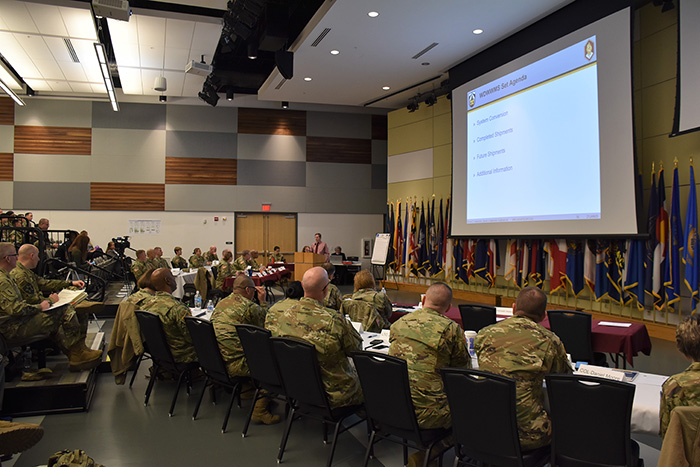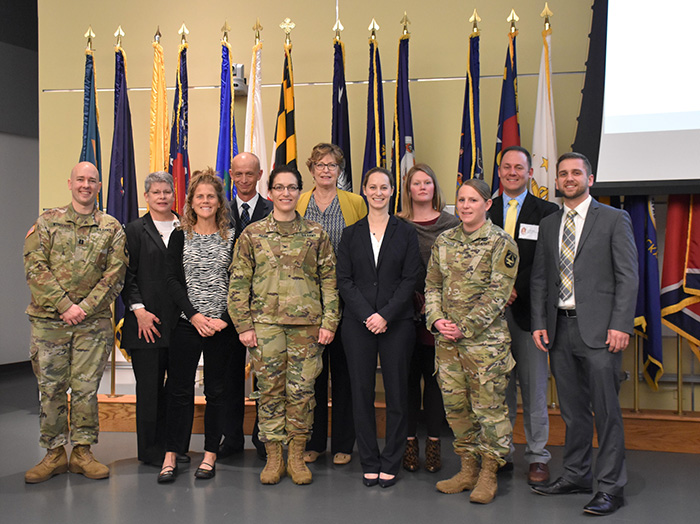USAMMDA Hosts Army Hospital Center Conversion Summit
From Combat Support Hospitals to the Hospital Center configuration

The U.S. Army Medical Materiel Development Activity held its 2020 Army Hospital Center Conversion Summit at Fort Detrick, Maryland, January 21. Nearly 200 attendees gathered in the post's community auditorium to participate in a wide variety of discussion topics focused on the requirements, equipment, personnel and logistical aspects surrounding the ongoing conversion of Army Combat Support Hospitals to Hospital Centers, both within and outside of the United States.
Army Brig. Gen. Michael J. Talley, commanding general of the U.S. Army Medical Research and Development Command and Fort Detrick, welcomed the participants and provided the opening remarks for the day's events.
"I really appreciate everyone coming out to continue the great partnership that we have here with Army Medicine," said Talley. ... "It's very important that we get together like this, as a community."
"I would ask that you take this one-day conference, and roll up your sleeves," he said later. "Let's be productive and let's be constructive, but more importantly, let's think about how we can ensure that we're able to save lives on the battlefield."
During his speech, the commanding general reviewed the priorities of the summit, along with the Army's initiatives and challenges with regard to its battlefield Role-of-Care medical program. As he wrapped up his welcome, Talley emphasized the positive results that can come from confronting challenges.
"Lessons learned, lots of lessons learned, collaboratively – where we can all come back together and drive change, to get the best solutions – that's what this day is all about," he said.
Immediately following this, Army Col. Gina E. Adam, commander of USAMMDA, introduced the project management teams and conference participants, and provided a brief overview of the focus and agenda for the summit.
"As General Talley mentioned, the organizational change from the Combat Support Hospital to the Hospital Center has been a major effort for all of us," said Adam. "But as usual with change, not everything has gone perfectly. So, with that, today is about coming together to continue to improve upon our conversion effort and our capabilities for the Warfighter."
"I know this meeting has really been successful in the past," she added. "So, I hope this is going to be a mutually beneficial day – to learn the status of where we are, where we're going with this initiative, and how we can better assist you with getting the items that you need."
Coordinated by USAMMDA's Warfighter Deployed Medical Systems Project Management Office, the day-long meeting featured speakers from across the Army, including the Medical Capability Development & Integration Directorate, Fielded Force & Integration Directorate, and USAMMDA's Warfighter Health, Performance and Evacuation PMO, as well as senior leaders from the Army's 531st Hospital Center, 131st Field Hospital, and Fort McCoy, Wisconsin, Regional Training Site.
Near the end of the morning session, the audience was given a demonstration of the Army Medical Command's Hospital Center AutoDISE Toolbox. AutoDISE is a state-of-the-art software program created specifically to assist in the design and layout of the new Hospital Center configuration as well as predict power and fuel consumption. As an upgrade over the legacy Combat Support Hospital design, this new tool allows Army units to construct a visual footprint of the proposed Hospital Center, taking into account the square footage and topography of the allotted space. Users plot the specific information into the software program to see what the structure will look like in final form.
Army Maj. Janessa Moyer, WDMS PMO Medical Modernization product manager, is tasked with oversight of the Hospital Center conversion program, which began in 2016. Moyer said the project is now more than 50 percent complete, and should be finalized in 2022.

"The Hospital Center Conversion summit is a great forum to bring together all of our stakeholders across the enterprise, to discuss some of the lessons learned and best practices, with regard to employment of the new modular Hospital Center configuration," said Moyer.
"Our PMO team has been in charge of this conversion project since 2018, while we were under the U.S. Army Medical Materiel Agency," she continued. "Now that we've transitioned under USAMMDA, we are using this event to explain the new organizational structure to our customers."
Moyer was pleased at the large turnout for the conference, which included two general officers and personnel from the U.S. Army Forces Command, U.S. Indo-Pacific Command, U.S. Army Medical Command, and the U.S. Army Health Readiness Center of Excellence, among others.
The summit's afternoon portion featured three successive panel discussions aimed at providing information on the topics of Army Class VIII equipment, Class VII equipment, and Personnel and Organizational Structure. These sessions produced a lively exchange of information between the audience and panel members, with valuable insight coming from both groups.
"For the panel sessions, we were pleased to have key stakeholders from the operational side with us to discuss issues, challenges, best practices and lessons learned," said Moyer. "These include commanders of Hospital Center entities who have performed numerous exercises with their units, so they were able to provide unique insight regarding the various discussion topics."
"Our planning team researched many of the common concerns prior to the summit, so we could identify specific stakeholders who have experienced some of the challenges and constraints with the design, and we asked them to participate in the panel discussions to help address these issues," she added.
Moyer went on to commend the entire conference planning team for its dedication and efforts to ensure a successful meeting this year.
"Our Medical Modernization team worked hard to make sure the commanders are confident in their organizational structure, and that the key issues they face are highlighted up to every partner who may have a hand in correcting or improving the system, for the evolution of future contingency issues," she said.
Moyer confirmed the summit will continue to be held annually, for stakeholder collaboration and discussion, as the remaining number of Army Hospital Centers are converted as planned. She continued by saying this type of forum provides a great platform for making proper adjustments to the system, as everyone is able to work together openly to determine the best course of action going forward.













